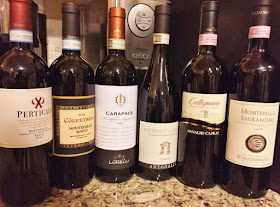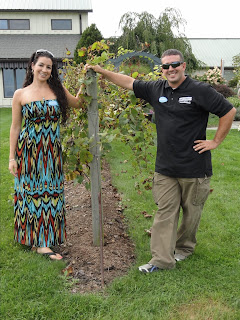Welcome back to
Italian Food, Wine & Travel (#ItalianFWT) for our 12th
month. Gosh, we have covered so many regions of Italy and are in
our 2nd half of the country. Last month we shared with
you our experiences in the region of Abruzzo
and this month we take you to central Italy again, but to the
region of Umbria this time. Many folks say that Umbria is in
the shadows of Tuscany, but this week we're going to show you why
Umbria needs to be considered in it's own spotlight for all it's
beauty and what it offers to those that visit it.
 |
| Map of Umbria copyright of Federdoc |
Umbria is a
fertile, hilly region also known as the “green heart of Italy”.
It's the only region within Italy that is landlocked surrounded by
the regions of Tuscany, Lazio and the Marche. Even though it doesn't
have the sea influences as many of the other regions there is Lake
Trasimeno and Lake Bolsena within the region that create milder
microclimates.
Travel in Umbria
There are so many
great medieval towns worth visiting within Umbria and all known for
their own highlights. My last trip to Italy brought me back to
Umbria for my 2nd time to gawk at the Gothic Duomo in the
hilltop town of Orvieto and relax in the peacefulness of Assisi,
especially at the Basilica of St. Francis of Assisi. To celebrate
the renaissance of Italy one must visit to the town of Urbino and the
Palazzo Ducale. For wine lovers there is not only the town of
Orvieto to visit, but also Torgiano and Montefalco. Other towns of
of note are Spoleto, Todi and Gubbio.
Food of Umbria
Every region has
their own specialities and Umbria is known for a number of food
delights. One of it's best known gems are tartufo nero, black
truffles. They are a very distinct taste with their intense
aromatics and powerful flavors. Pork is very common throughout this
region as well, especially in the town of Norcia. Beans, including
lentils and farro, are most popular in the town of Castelluccio di
Norcia. To top it all off for my chocolate lovers one must visit the
chocolate festival in October in Perugia or year round you can make a
stop at at the Perugina factory for some fresh samples. It's a
calorie free tour of course!
 |
| Black truffles of Umbria by Umbria lovers |
Wines of Umbria
Wines have been
produced in Umbria since the settlements of the Etruscans as well as
the Romans. If you enjoy white wine, Umbria is dominated by Orvieto.
These wines are named after the local town and are made primarily
from the grechetto and procanico, aka trebbiano, grapes. For red
wines, sangiovese and sagrantino
are the primary grapes and are well worth lots of recognition for
their power structure.
Here is a preview of our upcoming blogs on the region of Umbria:Vino Travels: Immersion in Umbrian wine with Sagrantino
The Palladian Traveler - Marcello's Big Fat Italian Christening
Orna O'Reilly - Castelluccio di Norcia: On the Rooftop of the Apennines
Culinary Adventures with Camilla - Roasted Flank Steak with Zucchini Mint Pesto with an Umbrian Merlot
Italophilia - Visiting Assisi in the Enchanting Umbrian Hills
Flavourful Tuscany - Umbrian Cuisine and Fun Facts
Rockin Red Blog - Beauty and the Beast
Enofylz Wine Blog - Umbria's Sagrantino: Call It a Comeback
Food Wine Click - Orange is the New Red: Paolo Bea Santa Chiara & Umbrian Steak on FoodWineClick
The Wining Hour - Taste Umbria - Black Truffle Linguini with Shrimp & Montefalco Sagrantino
Cooking Chat Food - Rigatoni with Collard Greens & Sausage with Wine from Umbria
Join us this Saturday October 3rd at 11am EST on twitter at #ItalianFWT to share your experiences with Umbria. There is still time to join our group as well so shoot me an email at vinotravels at hotmail dot com.




























